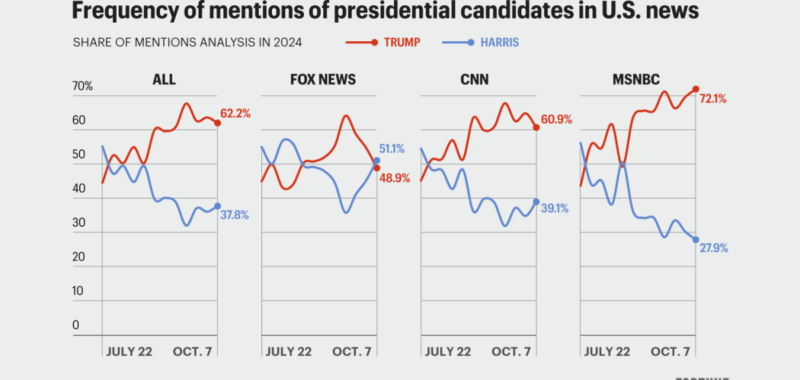If Kamala Harris wins the U.S. presidential election it will be in spite of the U.S. news media. If Donald Trump is elected, he will have been assisted by the news media, which has consistently acted as a springboard for brand Trump. Either way, in this nail-bitingly tight race, the role of the media is going to be pivotal to the outcome.
What Donald Trump seems to understand better than anyone is the critical role that mere brand recognition plays in voters’ choices. And almost no cost is too high for him to obtain it. “There is no bad press unless you are a pedophile”, Trump reportedly once told his advisors. This scandal-reliant, news-sticky strategy has made him extremely successful in using the news media to strengthen his brand.
Presidential candidate recognition will be particularly important for the 5% of voters who are undecided and the 3% of voters who are wavering. Following the 2016 U.S. election, Regina Lawrence argued in an analysis of media’s influence on election outcomes that simple name recognition is the biggest driver of elections. When it comes to name recognition, Kamala Harris is in a hugely disadvantaged position, despite a recent media blitz aimed at boosting her familiarity among undecided voters. Given news media’s systematic spotlighting of Trump, matching his brand recognition is a difficult brief.
In 2010, five years before Trump went into politics, Byron Sharp shook up the world of marketing with his groundbreaking book How Brands Grow. He challenged conventional wisdom by showing evidentially that to win new customers, brands need to increase their awareness among as large a pool of people as possible rather than focus on widening and deepening their relationship with a core target group. In his presidential win six years later, Trump provided a textbook example of how to apply this. By orchestrating constant controversies, he used the news media as a marketing tool to widen his recognition—and continues to do so successfully today. What the news media receives in return for covering these mostly dismaying stories is higher audience numbers and traffic.
The new findings from the AKAS U.S. Election Media Tracker, fuelled by GDELT’s TV archive, reveal that since Trump appeared on the election scene, his name has dominated the news. In the last three presidential campaigns, Trump has had a significantly higher share of mentions than other candidates on CNN, Fox News, and MSNBC. In 2016, his share of mentions averaged at 61% vs. Hillary Clinton’s 39% between July and October. In the same period in 2020, the percentage of Trump mentions averaged at 59% vs. Joe Biden’s 41%. In 2024, Harris’s share of mentions has averaged 43% across the current campaign vs. 57% for Trump. However, since August this year, the share of mentions of Trump on the Democrat-leaning CNN and MSNBC has been gaining startling momentum. So much so that the latest results from the week commencing Oct. 7 show a whopping 72% share of mentions for Trump on MSNBC and 61% on CNN.
When the news covers Trump, the public acts. AKAS’s analysis of Google search trends following online news coverage referencing Trump’s name uncovered an extraordinarily strong relationship between the two. Online news coverage that mentions Trump is followed by surges in Google searches of his name in the same week.
In a recent Rutgers University article, Prof. Lauren Feldman argued that news media can shape the outcome of an election in many ways, including through the disproportionate amount of attention it gives to each candidate and to specific policy issues. Donald Trump has an enormous advantage over Kamala Harris, not only because she is relatively new to the political limelight and does not employ a scandal-based media strategy but also because the news industry has been and remains obsessed with Donald Trump. So much so that he acts as a major agenda-setter of news.
For example, according to AKAS’ US Election Media Tracker, after the Trump/Harris TV debate in which Trump falsely accused Springfield’s Haitian immigrants of eating their neighbors’ pets, Springfield received more mentions in online news coverage than the economy, immigration, or climate change for the following two crucial weeks in September.
To avoid tilting the volume of coverage towards one candidate, U.S. news media can learn from the BBC, the U.K.’s public service broadcaster, which was deliberate in its 2024 General Election Guidelines, stating that parties or candidates must be covered “proportionately over an appropriate period” in its reporting.
U.S. news media still have a few days left to rebalance and fine-tune election coverage. Surveys show that the public, especially those yet to decide who to vote for, are most likely to engage with election coverage in the final couple of weeks before polling day. In 2020, it was only in the last two weeks before the election that the majority of the U.S. public paid “a lot” of attention to the candidates’ campaigns.
Although the finishing line is in sight, news media still has the opportunity to give both presidential candidates a fair and proportionate voice and focus on the most important issues before Americans cast their votes on Nov. 5.

